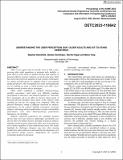Understanding the User Perception Gap: Older Adults and Sit-to-Stand Assistance
Author(s)
Stansfield, Stephan; Schelhaas, Booker; Hogan, Neville; Yang, Maria
DownloadPublished version (2.095Mb)
Publisher Policy
Publisher Policy
Article is made available in accordance with the publisher's policy and may be subject to US copyright law. Please refer to the publisher's site for terms of use.
Terms of use
Metadata
Show full item recordAbstract
<jats:title>Abstract</jats:title>
<jats:p>There is an urgent need to provide ways to help a fast-growing older adult population to maintain daily mobility. A great deal of work exists in medical devices and robotics to generate effective assistive solutions, yet at the same time, limits have been observed in the adoption of such systems. In this paper we explore possible factors in adoption from a user-centered design perspective. We investigated user needs surrounding the act of standing up from a seated position and older users’ attitudes toward assistive device prototypes.</jats:p>
<jats:p>Older adults completed a standard timed-up-and-go mobility assessment, rated their own difficulty standing, participated in interviews, and shared responses to “look-and-feel” prototypes, all in an effort to uncover latent needs. A licensed physical therapist rated videos of the subjects while standing up and the two ratings were compared. While the physical therapist’s rating of difficulty increased as subjects’ performance on the clinical mobility assessment worsened, subjects’ self-ratings did not significantly correlate with mobility performance, even when timed-up-and-go performance indicated a risk of falling.</jats:p>
<jats:p>Subjects expressed preferences for potential assistive devices that were more discreet, lightweight, and flexible over devices that were bulkier, heavier, and rigid. In general, subjects’ attitudes toward assistive devices for their own sit-to-stand use were similar regardless of their demonstrated need. The results highlight the challenges designers may face when creating products for older adult users and underline the importance of a user-centered design process. Implications for assistive technology design are discussed.</jats:p>
Date issued
2023-08-20Department
Massachusetts Institute of Technology. Department of Mechanical EngineeringJournal
Volume 6: 35th International Conference on Design Theory and Methodology (DTM)
Publisher
American Society of Mechanical Engineers
Citation
Stansfield, Stephan, Schelhaas, Booker, Hogan, Neville and Yang, Maria. 2023. "Understanding the User Perception Gap: Older Adults and Sit-to-Stand Assistance." Volume 6: 35th International Conference on Design Theory and Methodology (DTM).
Version: Final published version